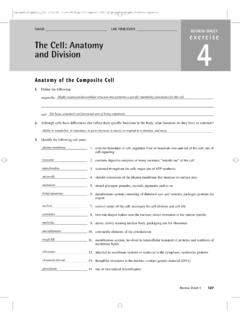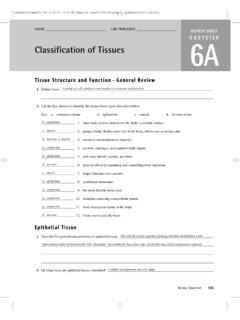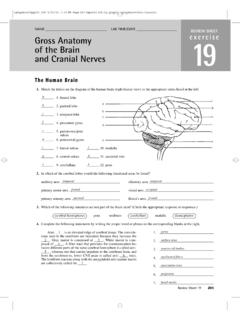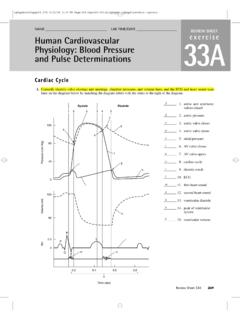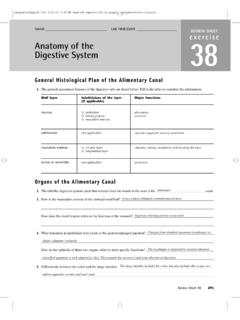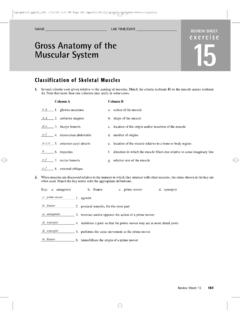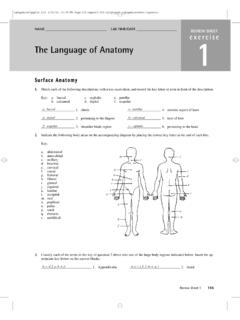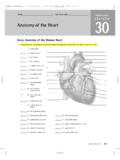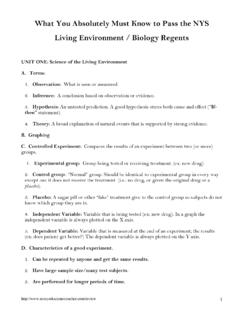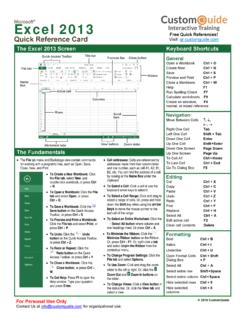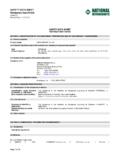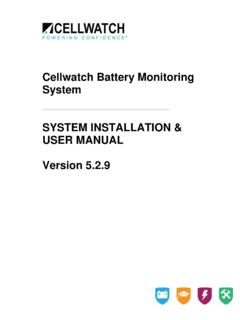Transcription of NAME LAB TIME/DATE REVIEW SHEET The Integumentary …
1 REVIEW SHEET exercise7 The IntegumentarySystemReview SHEET 7143 Basic Structure of the the following statements by writing the appropriate word or phrase on the correspondingly numbered blank:The two basic tissues of which the skin is composed are dense irregularconnective tissue, which makes up the dermis, and 1, which forms the epi-dermis. The tough water-repellent protein found in the epidermal cells is called2. The pigments melanin and 3contribute to skin color. A localizedconcentration of melanin is referred to as a protective functions of the skin are . the key choices, choose all responses that apply to the following :a. stratum basaled. stratum lucidumg. reticular layerb. stratum corneume.
2 Stratum spinosumh. epidermis as a wholec. stratum granulosumf. papillary layeri. dermis as a whole1. translucent cells in thick skin containing keratin fibrils2. dead cells3. dermis layer responsible for fingerprints4. vascular region5. major skin area that produces derivatives (nails and hair)6. epidermal region exhibiting the most rapid cell division7. scalelike dead cells, full of keratin, that constantly slough off8. mitotic cells filled with intermediate filaments9. has abundant elastic and collagenic fibers10. location of melanocytes and Merkel where weblike prekeratin filaments first appear12. region of areolar connective _____LAB TIME/DATE _____stratified squamous epitheliumkeratincarotenefrecklePrevents dessication, protects against thermal damage, prevents bacterial invasion, and protects against UV ; stratum lucidumb strata corneum and lucidumf; papillary layeri; dermis (or f, g)h; epidermisa; stratum basaleb; stratum corneume; stratum spinosumi; dermis (or g)a; stratum basalee; stratum spinosumf; papillary layerighapmLre07pg143_146 5/12/04 12:54 PM Page 143 impos03 302:bjighapmL:ighapmLrevshts: the skin structures and areas indicated in the accompanying diagram of thin skin.
3 Then, complete the statements that extruded from the keratinocytes prevent water loss by diffusion throughthe in the dermis are produced by . that respond to rising androgen levels are the cells that occupy the epidermis are called . unique touch receptor formed from a stratum basale cell and a nerve fiber is a . layer is present in thick skin but not in thin skin? cell-to-cell structures hold the cells of the stratum spinosum tightly together? substance is manufactured in the skin (but is not a secretion) to play a role elsewhere in the body?Subcutaneoustissue or(deep pressure receptor)StratumStratumStratumStratum(la yers)Reticular layerBlood vesselAdipose cells144 REVIEW SHEET 7 Laminated (or lamellated)fibroblastssebaceous (and apocrine sweat)Langerhans cellsMerkel discStratum lucidumDesmosomesEpidermiscorneumHair shaftgranulosumspinosumbasaleHair rootDermal papillaeSebaceous glandHair follicleArrector pili muscleSweat glandHair bulbNerve fiberDermishypodermisPacinian corpuscleVitamin DighapmLre07pg143_146 5/12/04 12:54 PM Page 144 impos03 302:bjighapmL:ighapmLrevshts: the sensory receptors found in the dermis of the skin.
4 Nurse tells a doctor that a patient is cyanotic. Define cyanosis. What does its presence imply? is the mechanism of a suntan? is a bedsore (decubitus ulcer) ? Why does it occur? injections hurt more than others. On the basis of what you have learned about skin structure, can you determine whythis is so? Appendages of the key choices, respond to the following :a. arrector pilid. hair follicleg. sweat gland apocrineb. cutaneous receptorse. nailh. sweat gland eccrinec. hairf. sebaceous glands1. produces an accumulation of oily material that is known as a blackhead2. tiny muscles, attached to hair follicles, that pull the hair upright during fright orcold3. perspiration glands with a role in temperature control4.
5 Sheath formed of both epithelial and connective tissues5. less numerous type of perspiration-producing gland; found mainly in the pubicand axillary regions6. found everywhere on body except palms of hands and soles of feet7. primarily dead/keratinized cells8. specialized nerve endings that respond to temperature, touch, etc9. its secretion is a lubricant for hair and skin10. sports a lunula and a cuticleReview SHEET 7145 Pain, pressure, touch, heat, and blue cast to the oxygenation of the exposed to UV radiation, the melanocytes produce more protective melanin and the skin becomes more brown in area of tissue necrosis and areas (points of increased pressure over bony areas) restrict the blood supply to the depends on the relative number of pain receptors ; sebaceous glandsa; arrector pilih; sweat gland eccrined; hair follicleg; sweat gland apocrinef; sebaceous glandsc, e; hair, nailb; cutaneous receptorsf; sebaceous glandse.
6 NailighapmLre07pg143_146 5/12/04 12:54 PM Page 145 impos03 302:bjighapmL:ighapmLrevshts: two Integumentary system mechanisms that help in regulating body temperature. structures or skin regions are listed below. Identify each by matching its letter with the appropriate area on the the Distribution of Sweat what substance in the bond paper does the iodine painted on the skin react? on class data, which skin area the forearm or palm of hand has more sweat glands? Was this an expected result? Explain. Which other body areas would, if tested, prove to have a high density of sweat glands? organ system controls the activity of the eccrine sweat glands? Dermography: can fingerprints be used to identify individuals?
7 The three common fingerprint patterns., , and a. Adipose cellsb. Dermisc. Epidermisd. Hair folliclee. Hair shaftf. Sloughing stratum corneum cells146 REVIEW SHEET 7(1) When capillary blood flow tothe skin is enhanced (by nervous system controls), heat radiates from the skin surface; restriction of blood flow conserves body heat. (2)Activity of sweat glands, , when perspiration evaporates from the skin surface, heat is starchPalmYe sFor most people, hands sweat more than the , axillaeNervous system (sympathetic division)f ebd a cEveryone s fingerprints are genetically 5/12/04 12:54 PM Page 146 impos03 302:bjighapmL:ighapmLrevshts:layouts.
